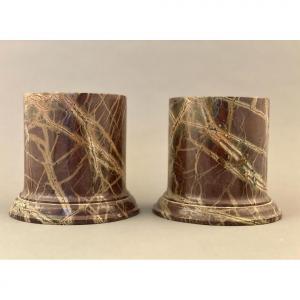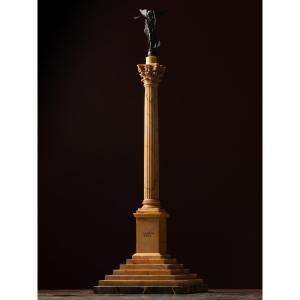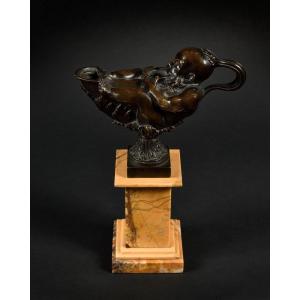Gouache on paper.
Italy.
Before 1812.
h. 18,5 in. ; w. 22 in.
These two gouaches belong to a large group of subjects that, for a long time, were attributed to Raphael. They were widely disseminated at the end of the 18th century, most often for a clientele of 'grand tourists' — the elites who traveled from all over Europe to Italy during their 'Grand Tour' to see Greek and Roman antiquities, as well as the most famous works of art, chief among them those by Michelangelo and Raphael.
A series of twelve Greco-Roman deities, including the present Mars and Diana, is known through a set of engravings designed by Carlo Lasinio, a famous engraver active in Florence at the end of the 18th century. However, there exists another, rarer, and older set of engravings, although based on the same model, created by Roman engravers Pietro Bettelini and Pietro Fontana, rather than Florentine ones. These two engravers, well integrated into the Roman artistic community, were close to Thorvaldsen and Canova, and also had in their circle the painter Michelangelo Maestri, whose signature and dedication appear on twelve prints published by Bettelini and Fontana, now held in the British Museum.
The present paintings are also by Michelangelo Maestri, who died in 1812 in Rome, and was famous for his gouaches painted after Raphael-esque and Pompeian subjects. The quality of Maestri’s work here is particularly refined, and one might believe that every stroke, in the modeling, follows the hatching of an engraver, were it not for the visible brushstrokes and corrections made by the painter-draftsman in certain places.
In truth, this cycle of twelve gods is a cycle of twelve "planets," as mentioned by Montagnani in his description of the engravings that reveal the composition of the frescoes in the Sala Borgia. He describes the Volta della Sala Borgia nel Palazzo Vaticano ove sono espressi i Pianeti, le Ore del giorno, ed i segni del Zodiaco dell'immortal Rafaello Sanzio da Urbino. Thus, we are dealing here not with Artemis and Ares, but with the Moon and Mars, the two celestial bodies closest to the Earth. The model for these figures, now lost, was not created by Raphael, as was once thought, but by his disciples Giovanni da Udine and Perino del Vaga, likely painting from the master’s cartoons.
Each of these gouaches is framed with a superb Empire-period mahogany frame, finely sculpted with friezes of ovals and darts and adorned with sculpted and gilded rosettes applied at the corners.
Some cracks are visible on the frame.
Sources
Joseph Archer Crowe et Giovanni Battista Cavalcaselle, Raphael. His Life and Works, t. II, London, 1882 ; John Pope-Hennessy, Raphael, New York, 1970.































 Le Magazine de PROANTIC
Le Magazine de PROANTIC TRÉSORS Magazine
TRÉSORS Magazine Rivista Artiquariato
Rivista Artiquariato